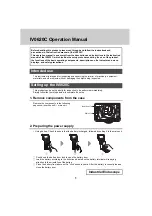
8
3.9 F3 Plot Data Properties
The VIA Bravo MRI can graph up to two plots on the display. More plots may be
displayed if you connect the VIA Bravo MRI to a PC running the VIA-RTD software. In
addition to the two plots, some information is also displayed numerically. When the plotting
width is 100 points, all of the center frequency data is displayed with small digits. When the
plot width is 80 points, the left plot and right plot values at the center frequency are displayed
with large digits (viewable from 8 to 10 feet). Additionally the 80 point sweep displays using
large digits, the calculated Q of the Z curve (in VIA operation) or the SWR curve (in SWR
operation) is displayed in the third position.
3.9.1 Left Plot Data
This sub menu allows you to choose which data to plot on the left axis with the non
hashed curve. The data types depend on the instrument mode. The center frequency value
is also displayed numerically.
3.9.1.1 VIA Operation
The information for this mode is the same info that can be extracted or plotted on a
Smith Chart.
3.9.1.1.1 Total Impedance
This is the total Z of the load. It is equal to the square root of the sum of resistance
squared and reactance squared. If resistance and reactance are made to be the two legs of
a right triangle, the total Z is the hypotenuse.
3.9.1.1.2 Impedance Angle
The impedance angle is the ratio of resistance to reactance, expressed in degrees. It is
equal to the arctan of reactance divided by resistance. Note that this angle is a bipolar
quantity, so zero is near the middle of the plotting range, the x axis is down at the maximum
negative, and the maximum positive is still near the top of the plot.
3.9.1.1.3 Resistance
Standard resistance, measured in ohms. This is the portion of the Z that is non reactive.
3.9.1.1.4 Reactance
The reactance is the non resistive portion of the total impedance caused by capacitance
or inductance. Reactance is also a bipolar quantity, thus zero reactance is at the middle of
the plot range.
3.9.1.1.5 Q Factor
The 3dB bandwidth of the Z curve is used to calculate the circuit Q. The Q is displayed
numerically when the sweep width is at 80 points and one of the plots is Z.
Содержание VIA Bravo MRI
Страница 1: ...MRI Network Analyzer MRI Network Analyzer 100KHz to 70 MHz ...
Страница 42: ...38 NOTES ...
Страница 43: ...39 NOTES ...













































